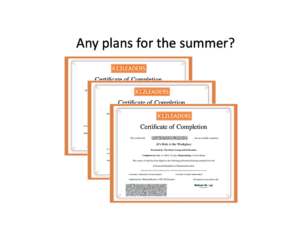Tech’ing it One Step at a Time: Reflections on supporting diverse learners to thrive in a digital world
As someone who transitioned from a career in medical speech language pathology to K-12 education, I’ve witnessed firsthand the disconnect between students’ brilliant ideas and their ability to express them through traditional means. This gap is particularly evident for students with language disabilities and learning differences who have so much to contribute but lack the tools to bridge that gap.
Finding Pathways Through Technology
My journey began with noticing the specific barriers students face. For middle school students with language learning disabilities, figurative language—idioms, multiple-meaning words, and metaphors—created significant obstacles both academically and socially.
The breakthrough came through what I call “visual language bridges”—using AI-enabled tools to generate visual interpretations of both literal and figurative meanings of language. Students who previously shut down during these lessons suddenly became active participants, moving from feeling excluded to confidently understanding metaphors and even creating their own.
This transformation wasn’t just about academic achievement—it was about enabling full participation in both classroom discussions and social interactions. When technology removes barriers rather than creating new ones, it becomes a bridge to understanding and expression.
The Gaps in EdTech
Despite our progress, significant gaps remain in educational technology. Perhaps most glaring is that most EdTech is designed for an “average” student who doesn’t actually exist. We’re still missing robust, accessible design principles that center students with disabilities from the beginning—not as an afterthought.
To address this challenge, I’ve been seeking partnerships with industry to ensure diverse perspectives are included in the design process itself. Another critical gap lies in professional learning. We can have the most innovative tools, but if educators don’t understand how to implement them effectively with an equity lens, we’re missing the opportunity.
The promise of educational technology has never been about the newest features—it’s about creating pathways for every learner to express their unique brilliance and participate fully in both education and community.
AI: Bridge or Barrier?
AI has real potential as an equalizer in education, but like any tool, it’s all in how we implement it. For students with language learning disabilities, AI tools have created bridges to understanding complex language conventions that previously seemed completely inaccessible.
However, AI isn’t inherently equitable—it reflects both the data it’s trained on and the intentions of its designers. The true equalizing potential emerges when AI handles the mechanical barriers that have traditionally excluded certain students, freeing them to focus on higher-order thinking, creativity, and authentic expression.
Beyond Device Bans
The conversation around student wellbeing often leads to discussions about technology restrictions in schools. Yet these blanket approaches miss important nuances, particularly for students who rely on technology for access. For some of my students, supportive technology is absolutely essential for their academic success and emotional wellbeing.
A key distinction worth making is between consumption and creation. When students primarily consume content through devices, negative impacts are more common. But when they create, connect, and actively engage—technology becomes empowering.
Rather than focusing solely on restrictions, we need to equip students with skills for intentional and ethical technology use. The most successful approaches maintain clear frameworks for when and how technologies are used, while preserving flexibility for students who need these tools as accessibility supports.
Technology isn’t just about completing assignments—it’s about unlocking new ways of thinking, creating, and connecting.
Extending Impact Beyond Classrooms
Technology shouldn’t just be an in-school tool—it needs to bridge between school, home, and the broader world students will navigate. What I’ve found most impactful is teaching students to be their own advocates. When students discover tools that help them decode figurative language in social interactions, the impact extends far beyond any classroom assignment.
Schools must also better include families in understanding these tools and more explicitly connect technology skills to future opportunities. Technology isn’t just about completing assignments—it’s about unlocking new ways of thinking, creating, and connecting.
A Vision of Democratized Access
What began as a journey to seek solutions for students with language learning disabilities has evolved into a deeper understanding of how technology can democratize access for all learners.
When implemented thoughtfully, with intentional focus on removing barriers, technology becomes more than just a tool—it becomes a bridge to full participation in learning and life. This approach requires centering diverse learners in the design process, providing robust professional learning for educators, and embracing technology as a means to both academic and social inclusion.
The promise of educational technology has never been about the newest features—it’s about creating pathways for every learner to express their unique brilliance and participate fully in both education and community. When we keep this vision at the center of our work, technology truly becomes transformational.
Kim Zajac, is a certified SLP and Audiologist in Massachusetts. She is an ASCD/ISTE Community Leader, Educator Mentor for the Vital Prize Challenge, an Adobe Creative Educator Leader and Magic School Ambassador. Kim is a virtual practicum instructor at Speech@Emerson and is Co-Founder of EdCampSoutheasternMA. She is an FETC Featured Speaker and has presented at ASU GSV AIRShow, SXSWEDU, ISTE, MassCUE, & NYC Schools Tech Summit. Kim specializes in creating programs and sharing learning strategies to support students with diverse learning needs. She is passionate about establishing equitable access and inclusion for ALL students. You can connect with Kim here on K12 Leaders, LinkTree, LinkedIn or at Kimzajac1@gmail.com







